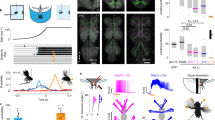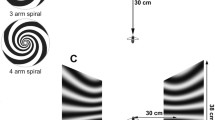Summary
Fruitflies (Drosophila melanogaster) may respond with landing reactions in tethered flight to unilateral progressive motion of single vertical dark stripes. The response frequency to repeated unilateral stimulation has a characteristic time course, a fast increase followed by a slower decrease. This behaviour is explained by the habituation of the input channels to a leaky integrator. The half-life of the integrated signal is in the range of 1 s. ‘Contralateral sensitization’ (CoS) describes the sensitization of the landing response to unilateral stimuli by preceding contralateral stimulation. It acts by increasing the initial reactivity, which habituates. The effects of CoS are thus still obvious after 1 min of repetitive stimulation. CoS can effectively be mediated by movement stimuli as well as by flickering light. We also show that binocular rotation rather than unilateral back to front motion inhibits the landing response (in the monocular part of the visual field). The biological significance of the described temporal characteristics of the landing response system and their possible neuronal basis are discussed.
Similar content being viewed by others
Abbreviations
- CoS :
-
contralateral sensitization
References
Bausenwein B (1988) Neuronale Aktivitätsmarkierung während visueller Flugsteuerung von Drosophila melanogaster. Dissertation, Universität Würzburg, FRG
Borst A (1989) Temporal processing of excitatory and inhibitory motion stimuli in the fly's landing system. Naturwissenschaften 76:531–534
Borst A (1990) How do flies land? From behavior to neuronal circuits. BioScience 40:292–299
Borst A, Bahde S (1986) What kind of movement detector is triggering the landing response of the housefly? Biol Cybern 55:59–69
Borst A, Bahde S (1987) Comparison between the movement detection system underlying the optomotor and the landing response in the housefly. Biol Cybern 56:217–224
Borst A, Bahde S (1988) Visual information processing in the fly's landing system. J Comp Physiol A 163:167–173
Braitenberg V, Taddei-Ferretti C (1966) Landing reaction of Musca domestica induced by visual stimuli. Naturwissenschaften 53:155–156
Buchner E, Buchner S, Bülthoff I (1984). Deoxyglucose mapping of nervous activity induced in Drosophila brain by visual movement. J Comp Physiol A 155:471–483
Buchner E, Bader R, Buchner S, Cox J, Emson PC, Flory E, Heizmann CW, Hemm S, Hofbauer A, Oertel WH (1988) Cell-specific immunoprobes for the brain of normal and mutant Drosophila melanogaster. Cell Tissue Res 253:357–370
Eckert H, Hamdorf K (1980) Excitatory and inhibitory response components in the landing response of the blowfly Calliphora erythrocephala. J Comp Physiol 138:253–264
Eckert H, Hamdorf K (1983) Does a homogeneous population of elementary movement detectors activate the landing response of blowflies, Calliphora erythrocephala? Biol Cybern 48:11–18
Eckert H, Flicke B, Hamdorf K (1979) Excitation and inhibition in the activation of the landing response of the blowfly Calliphora erythrocephala. Naturwissenschaften 66:368
Erber J, Schildberger KJ (1980) Conditioning of an antennal reflex of visual stimuli in bees (Apis mellifera L.). J Comp Physiol 135:217–225
Fischbach K-F (1981) Habituation and sensitization of the landing response of Drosophila melanogaster. Naturwissenschaften 68:332
Fischbach K-F (1983) Neurogenetik am Beispiel des visuellen Systems von Drosophila melanogaster. Habilitationsschrift, Würzburg
Fischbach K-F, Bausenwein B (1988) Habituation and sensitization of the landing response of Drosophila melanogaster. II. Receptive field size of habituating units. In: Herting G, Spatz H-Ch (eds) Modulation of synaptic transmission and plasticity in nervous systems. Springer, Berlin Heidelberg New York London Paris Tokyo, pp 369–386
Fischbach K-F, Dittrich APM (1989) The optic lobe of Drosophila melanogaster. I. A Golgi analysis of wild-type structure. Cell Tissue Res 258:441–475
Fischbach K-F, Waldvogel F-M (1988) Plasticity in the visual system of Drosophila melanogaster. In: Elsner N, Barth FG (eds): Sense organs. Georg Thieme, Stuttgart New York, pp 32
Goodman CS (1960) The landing responses of insects. The landing response of the fly Lucilia sericata and other Calliphorinae. J Exp Biol 37:854–878
Götz KG (1964) Optomotorische Untersuchungen des visuellen Systems einiger Augenmutanten der Fruchtfliege Drosophila. Kybernetik 2:77–92
Hausen K (1981) Monocular and binocular computation of motion in the lobula plate of the fly. Verh Dtsch Zool Ges 1981, pp 49–70
Heisenberg M, Wolf R (1984) Vision in Drosophila. Genetics of microbehavior. Springer, Berlin Heidelberg New York
Jacob KG, Willmund R, Folkers E, Fischbach KF, Spatz HCh (1977) T-maze photo taxis of Drosophila melanogaster and several mutants in the visual system. J Comp Physiol 116:209–225
Laughlin SB (1980) Neural principles in the visual system. In: Autrum H (ed) Handbook of Sensory Physiology, VII/6B. Springer, Berlin Heidelberg New York, pp 133–280
Kandel ER (1981) Behavioral biology of Aplysia. WH Freeman, San Francisco
Nässel DR (1988) Serotonin and serotonin-immunoreactive neurons in the nervous system of insects. Prog Neurobiol 30:1–85
Pollard JH (1977) Numerical and statistical techniques. Cambridge Univ Press, Cambridge
Precht M (1982) Bio-Statistik Teil 1: Eine Einführung für Studierende der biologischen Wissenschaften. Oldenbourg, München Wien
Rees C, Spatz HC (1989) Habituation of the landing response of Drosophila wild-type and mutants defective in olfactory learning. J Neurogenetics 5:105–118
Taddei-Ferretti C, Fernandez Perez de Talens A (1973) Landing reaction of Musca domestica IV. A. Monocular and binocular vision; B. Relationships between landing and optomotor reactions. Z Naturforsch 28c:579–592
Wehrhahn C, Hausen K, Zanker J (1981) Is the landing response of the housefly driven by motion of a flowfield? Biol Cybern 41:91–99
Wittekind W (1987) Analyse des stereotypen und insbesondere plastischen Landeverhaltens von Drosophila melanogaster. Dissertation, Universität Freiburg, FRG
Wittekind WC, Spatz HCh (1988) Habituation of the landing response of Drosophila. In: Herting G, Spatz HC (eds) Modulation of synaptic transmission and plasticity in nervous systems. Springer, Berlin Heidelberg New York London Paris Tokyo, pp 351–368
Author information
Authors and Affiliations
Rights and permissions
About this article
Cite this article
Waldvogel, FM., Fischbach, KF. Plasticity of the landing response of Drosophila melanogaster . J Comp Physiol A 169, 323–330 (1991). https://doi.org/10.1007/BF00206996
Accepted:
Issue Date:
DOI: https://doi.org/10.1007/BF00206996




